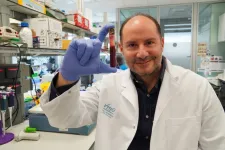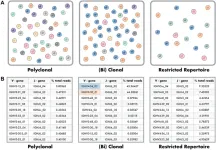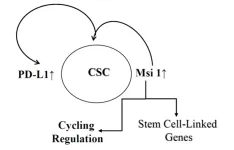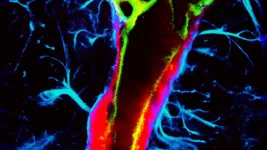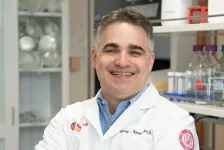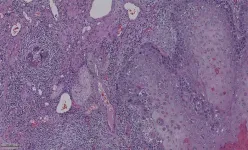(Press-News.org) Liquid biopsy is increasingly stepping up as a non-invasive approach in detecting and tracking circulating tumor DNA (ctDNA) in blood and providing crucial insights into the dynamics of cancer evolution and intra-tumor heterogeneity as drivers of cancer drug resistance.
One main limitation of liquid biopsy to-date is the low sensitivity of current approaches in tumor types that do not shed enough DNA into the bloodstream, including pancreatic cancer.
Co-led by VHIO’s Rodrigo A. Toledo, a study published in Genome Medicine (1) reports on the development of a novel ctDNA-based approach, Aneuploidy in Circulating Tumor DNA (ACT-Discover), that identifies subclonal copy number alterations in pancreatic cancer evolution.
Incorporating comprehensive analysis of blood samples, with data from germinal DNA and tumor DNA, this new liquid biopsy methodology can detect ctDNA in 30% more patients with advanced pancreatic cancer.
Pancreatic cancer is the seventh leading cause of cancer death worldwide (2) and despite the increasing incidence of this disease, effective treatments are lacking and prognosis for patients with this tumor type remains poor, with approximately 70% of patients dying within one year of diagnosis. Advancing insights into the evolution and intra-tumor heterogeneity of pancreatic cancer is therefore crucial in identifying new therapeutic targets against this disease.
“Characterizing the vulnerabilities and evolutionary dependencies of pancreatic cancer that could lead to the development of more effective targeted therapies represents an unmet and urgent need,” says Rodrigo A. Toledo, Principal Investigator of the Vall d’Hebron Institute of Oncology’s (VHIO) Biomarkers and Clonal Dynamics Group.
Published in Genome Medicine (1), a study co-led by Rodrigo A. Toledo alongside Manuel Hidalgo, Chief of the Division of Hematology and Medical Oncology at Weill Cornell Medicine/New York-Presbyterian Hospital (New York, USA), and Nicholas McGranahan, Leader of the Cancer Genome Evolution Research Group at the Cancer Research UK Lung Cancer Centre of Excellence, University College London Cancer Institute (London, UK), reports on the development of a new liquid biopsy approach, ACT-Discover - Aneuploidy in Circulating Tumor DNA (ctDNA), and shows that this technique is 30% more sensitive than current methods in patients with advanced to
“ctDNA analysis by liquid biopsy prior to treatment and in series throughout the course of disease allows us to identify and track the genetic or molecular alterations that occur in the tumor and achieve a better understanding of pancreatic cancer. This technology is being increasingly applied across different tumor types to identify mutations that can greatly affect drug sensitivity and therefore help guide treatment decision making,” observes Rodrigo A. Toledo, co-corresponding author of this present study and coordinator of the liquid biopsy working group of the CIBERONC Spanish Biomedical Research Centre in Cancer network.
“This non-invasive approach for tracking cancer in real time does however have certain limitations. One current challenge is that some tumors, including pancreatic cancer, do not release enough ctDNA into the bloodstream to be detected by current liquid biopsy approaches,” adds Ana Belen Moreno, a PhD student of Toledo’s group.
Potentiating liquid biopsy in pancreatic cancer
Aimed at addressing this challenge in pancreatic cancer, the investigators sought to develop a more sensitive liquid biopsy technique to detect ctDNA in blood and analyze genomic and molecular characteristics of tumors over time to advance insights into the evolution of disease.
“We have now developed a new liquid biopsy tool, ACT-Discover, that integrates plasma analysis and also incorporates the patient's germline DNA and tumor DNA obtained from biopsy specimens or through patient-derived xenograft models and or ctDNA,” says Teresa Macarulla, Principal Investigator of VHIO’s Upper Gastrointestinal and Endocrine Tumors Group and co-author of this present study.
In a cohort of 24 patients with late-stage pancreatic cancer, the researchers used ACT-Discover to study the progression of disease. Using this new liquid biopsy methodology, they have shown that this more comprehensive approach can detect ctDNA in 30% more patients compared with conventional liquid biopsy.
“Being able to access genetic and genomic insights in a non-invasive way, and to do so in series throughout the course of disease, provides valuable information to deliver on the true promise of precision cancer medicine in an increasing number of tumor types, including pancreatic cancer,” adds co-corresponding author Manuel Hidalgo.
“Our results underpin the importance of sampling approaches over time and across space in cancer as well as ctDNA-based approaches in tracking tumor evolution. Findings also highlight intra-tumor heterogeneity within advanced pancreatic cancer,” concludes Toledo.
###
References:
1. Huebner A, Black JRM, Sarno F, Pazo R, Juez I, Medina L, Garcia-Carbonero R, Guillén C, Feliú J, Alonso C, Arenillas C, Moreno-Cárdenas AB, Verdaguer H, Macarulla T, Hidalgo M, McGranahan N, Toledo RA. ACT-Discover: identifying karyotype heterogeneity in pancreatic cancer evolution using ctDNA. Genome Med. 2023 Apr 20;15(1):27.
2. Sung H, Ferlay J, Siegel RL, Laversanne M, Soerjomataram I, Jemal A, Bray F. Global Cancer Statistics 2020: GLOBOCAN Estimates of Incidence and Mortality Worldwide for 36 Cancers in 185 Countries. CA Cancer J Clin. 2021 May;71(3):209-249.
END
Researchers at Rutgers University have found a major flaw in the way that algorithms designed to detect "fake news" evaluate the credibility of online news stories.
Most of these algorithms rely on a credibility score for the "source" of the article, rather than assessing the credibility of each individual article, the researchers said.
"It is not the case that all news articles published by sources labeled 'credible' (e.g., The New York Times) are accurate, nor is it the case that every article published by sources labeled 'noncredible' publications are 'fake news,'" ...
Spooked by volatile reports from the Silicon Valley Bank in early March, many customers panicked and withdrew their money, creating the largest bank failure since the 2007-2008 financial crisis. The problem — investors and customers lost confidence in the bank, proving the perception of a banks’ reliability can significantly impact its success.
Investors tend to respond negatively to volatility in firms’ performance. To mitigate investors’ concerns, when some banks receive extremely high income, they occasionally delay reporting that amount until a later date when the income ...
“[...] we have developed a fully automated calling algorithm for determining B and T cell clonality from NGS [next-generation sequencing] data, with greater sensitivity than previously developed models.”
BUFFALO, NY- May 16, 2023 – A new research paper was published in Oncotarget's Volume 14 on May 12, 2023, entitled, “Development and implementation of an automated and highly accurate reporting process for NGS-based clonality testing.”
B and T cells undergo random recombination of the VH/DH/JH portions of the immunoglobulin loci (B cell) and T-cell receptors before becoming ...
“This study now links Msi 1 to PD-L1.”
BUFFALO, NY- May 16, 2023 – A new research paper was published in Aging (listed by MEDLINE/PubMed as "Aging (Albany NY)" and "Aging-US" by Web of Science) Volume 15, Issue 9, entitled, “Increased expression of musashi 1 on breast cancer cells has implication to understand dormancy and survival in bone marrow.”
Breast cancer (BC) stem cells (CSCs) resist treatment and can exist as dormant cells in tissues such as the bone marrow (BM). Years before clinical diagnosis, BC cells (BCCs) could migrate from the primary site where the BM niche ...
Irvine, Calif., May 16, 2023 — The MGAT5 glycosylation enzyme plays a crucial role in brain development, according to a study by University of California, Irvine researchers, a discovery that may contribute to new therapeutic purposes for neural stem cells.
Neurons, astrocytes and oligodendrocytes are the final mature cells of the brain and spinal cord formed by neural stem cells. Each has distinct and key functions. Neurons transmit signals, astrocytes help modify those signals, and oligodendrocytes ...
Like the lymphatic system in the body, the glymphatic system in the brain clears metabolic waste and distributes nutrients and other important compounds. Impairments in this system may contribute to brain diseases, such as neurodegenerative diseases and stroke.
A team of researchers in the McKelvey School of Engineering at Washington University in St. Louis has found a noninvasive and nonpharmaceutical method to influence glymphatic transport using focused ultrasound, opening the opportunity to use the method to further study brain diseases and brain function. Results of the work are published in the Proceedings ...
The prize, now in its 10th year, is given annually to at least six early-career scientists based in the New York City area by The Pershing Square Sohn Cancer Research Alliance. Prizes are awarded to scientists who are pursuing innovative cancer research and taking risks that might preclude them from traditional funding. Winners receive $250,000 a year for up to three years and access to networking opportunities and an annual retreat with past winners.
For Dr. Simon, the prize will allow him to apply his knowledge as a neuroscientist to cancer research. “I'm not a traditional cancer biologist,” said Dr. ...
A team from the University of Michigan Rogel Cancer Center and School of Dentistry, led by Yu Leo Lei, D.D.S., Ph.D., have identified a mechanism in mice for how obesity affects some oral cancers’ ability to escape from the immune system.
This study, published in Cell Reports, found that obesity helps to establish a type of tumor microenvironment that promotes tumor progression. How exactly this happens lies in the relationship between the saturated fatty acids, the STING-type-I interferon pathway, and NLRC3.
“We tend to think about the increased risks for gastrointestinal tumors, breast cancer, pancreatic cancer, and ovarian cancer when it comes to obesity,” ...
If you are a third grader, your chances of growing up to be a computer scientist is likely to heavily depend on your gender — a situation Allison Master says is just plain wrong.
How can Master be certain? Because third grade girls are telling her so.
“Our new research addresses a big, longstanding issue in STEM education, that women are highly under-represented in fields like computer science. It’s actually one of the most challenging fields for women’s representation. Only about 20% of people who major in computer science are women,” said Master, assistant professor ...
Researchers at the University of Michigan Rogel Cancer Center and the School of Dentistry identified a new metric to articulate the relationship between nerve density and oral cancer. The study, published in Clinical Cancer Research, a journal of the American Association for Cancer Research, investigated normalized nerve density to translate previous mechanistic studies into a context that could be used in the clinic.
“We are recognizing more and more that there's a very dynamic interaction between nerves and cancer cells in the tumor microenvironment,” said Nisha D’Silva, B.D.S., M.S.D, Ph.D., Donald Kerr Endowed Collegiate ...
